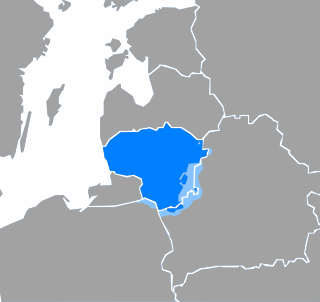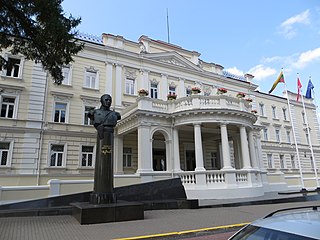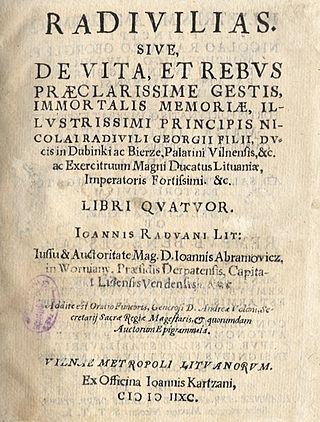
Lithuanian is an East Baltic language belonging to the Baltic branch of the Indo-European language family. It is the language of Lithuanians and the official language of Lithuania as well as one of the official languages of the European Union. There are approximately 2.8 million native Lithuanian speakers in Lithuania and about 1 million speakers elsewhere. Around half a million inhabitants of Lithuania of non-Lithuanian background speak Lithuanian daily as a second language.

The Lithuanian Soviet Socialist Republic, also known as Soviet Lithuania or simply Lithuania, was de facto one of the constituent republics of the Soviet Union between 1940–1941 and 1944–1990. After 1946, its territory and borders mirrored those of today's Republic of Lithuania, with the exception of minor adjustments to its border with Belarus.
AB Lietuvos Dujos was a natural gas company in Lithuania. It was established in 1961 as an integrated gas company for import, transmission, distribution and sale of natural gas. After privatization in the 1990s, its major shareholders became Gazprom and E.ON Ruhrgas. In 2009, the company operated around 1,800 km of trunk pipelines and 7,900 km of distribution pipelines, and employed around 1,820 people. In 2013, its transmission business was spun-off into a separate company Amber Grid. In 2014, Gazprom and E.ON sold their stakes to the state-owned energy company Lietuvos Energija. On 1 January 2016, Lietuvos Dujos was merged into Energijos Skirstymo Operatorius.

The Institute of the Lithuanian Language in Vilnius is a state-funded research institute that focuses on research into the Lithuanian language. The Institute of the Lithuanian Language is a research establishment with longstanding traditions. Founded in Vilnius back in 1941 on the basis of the Institute for Lithuanian Studies of Antanas Smetona. Today it is a state-level research body of special national importance.

The first known record of the name of Lithuania recorded in the Quedlinburg Chronicle in a 9 March 1009 story of Saint Bruno. The Chronicle recorded in the form Litua. Although it is clear the name originated from a Baltic language, scholars still debate the meaning of the word.

The National Museum of Lithuania, established in 1952, is a state-sponsored historical museum that encompasses several significant structures and a wide collection of written materials and artifacts. It also organizes archeological digs in Lithuania.

Alvydas Nikžentaitis is a Lithuanian historian, senior research fellow of the Lithuanian Institute of History and president of Lithuanian National Historians Committee.
History of Lithuania or Academic History of Lithuania is a thirteen-volume series of books dedicated to the history of Lithuania. Its first volume was published in 2005, and its last volume is scheduled for publication in 2011. After its completion, it will be the largest and the most comprehensive academic publication covering Lithuania's history ever released. As of 2011, five volumes had been released.

Lietuvos paštas is the company responsible for postal service in Lithuania. The company was re-established on 16 November 1918, and this date celebrate as Post Lithuania day.

The Genocide and Resistance Research Centre of Lithuania is a state-funded research institute in Lithuania dedicated to "the study of genocide, crimes against humanity, and war crimes in Lithuania; the study of the persecution of local residents by occupying regimes; the study of armed and unarmed resistance to occupying regimes; the initiation of the legal evaluation of the activities of the organisers and implementers of genocide; and the commemoration of freedom fighters and genocide victims." The centre was founded on 25 October 1992 by the Supreme Council of the Lithuanian Republic as the "State Genocide Research Centre of Lithuania". It is a member organisation of the Platform of European Memory and Conscience.

The Ministry of National Defence of the Republic of Lithuania is government institution in Lithuania responsible for the organization of national defence.
Česlovas Laurinavičius is a Lithuanian historian and political scientist, In 2003, he was the recipient of the Knight's Cross of the Order for Merits to Lithuania. Since 2001, he has served as the head of the Department of the 20th Century History at the Lithuanian Institute of History.

Radivilias is a Latin epic poem by Jonas Radvanas published in 1588. It is one of the major works of the 16th-century Lithuanian and Belarusian literature and one of the best examples of Renaissance literature in Lithuania. It uses hexameter and has 3,302 lines divided into four parts. It is dedicated to Mikołaj "the Red" Radziwiłł (1512–1584) and his major military victories in the Livonian War.

Tatar population in Lithuania is an ethnic group living in the Republic of Lithuania historical lands of Lithuania. It is also considered one of the oldest ethnic minorities in Lithuania.
Lithuanian Skating Federation or LČF is the national governing body of figure skating in Lithuania. The LČF organises the annual Lithuanian Figure Skating Championships.
Lithuanian Biathlon Federation is a national governing body of biathlon sport in Lithuania.

The State Tax Inspectorate or VMI is the tax authority in the Republic of Lithuania. It is an agency under the Ministry of Finance.
Ingė Lukšaitė is a Lithuanian cultural historian and university professor. She specializes in the history of the Reformation in Lithuania. She worked at the Lithuanian Institute of History for over four decades.
The Lithuanian Historical Society was a society of Lithuanian historians established in 1929 in Kaunas. It was the first society dedicated to history in Lithuania and was a sign of historians becoming more professional. It sought to improve historical research and historical publications, but was not very active. It published only two volumes of its journal Praeitis. It ceased activities after the Soviet occupation in June 1940. The society was reestablished during the Glasnost reforms and was active in 1988–2001.

Kyviškės airfield is a small regional airfield, opened in 1947, located in Kyviškės village, east of Vilnius. Runway, which is 540 meters in length and 23 meters in width, was thoroughly renovated in 2016. Traffic at the airfield is most intense during the summer months, with 200-300 daily lift-offs and landings. As of 2023, this airfield is primarily used for events and trainings, no domestic or international commercial routes operate here. Vilnius Airport located about 25 km away by car is the closest commercial airport.














